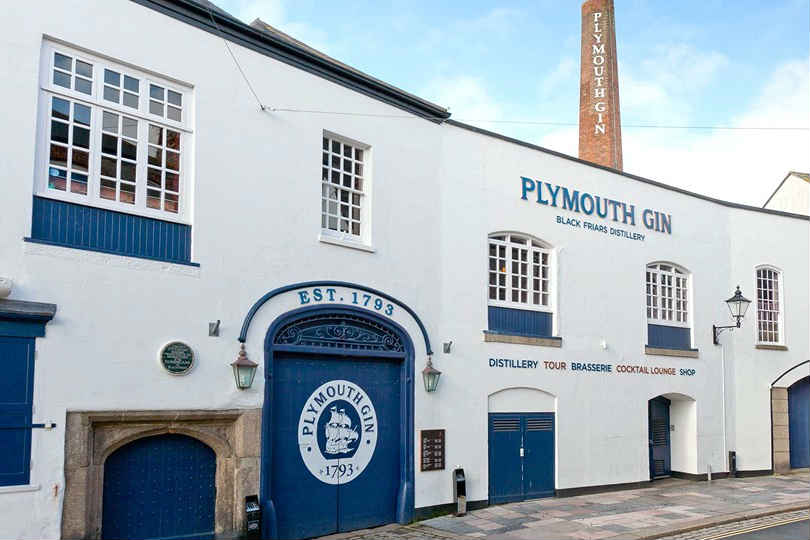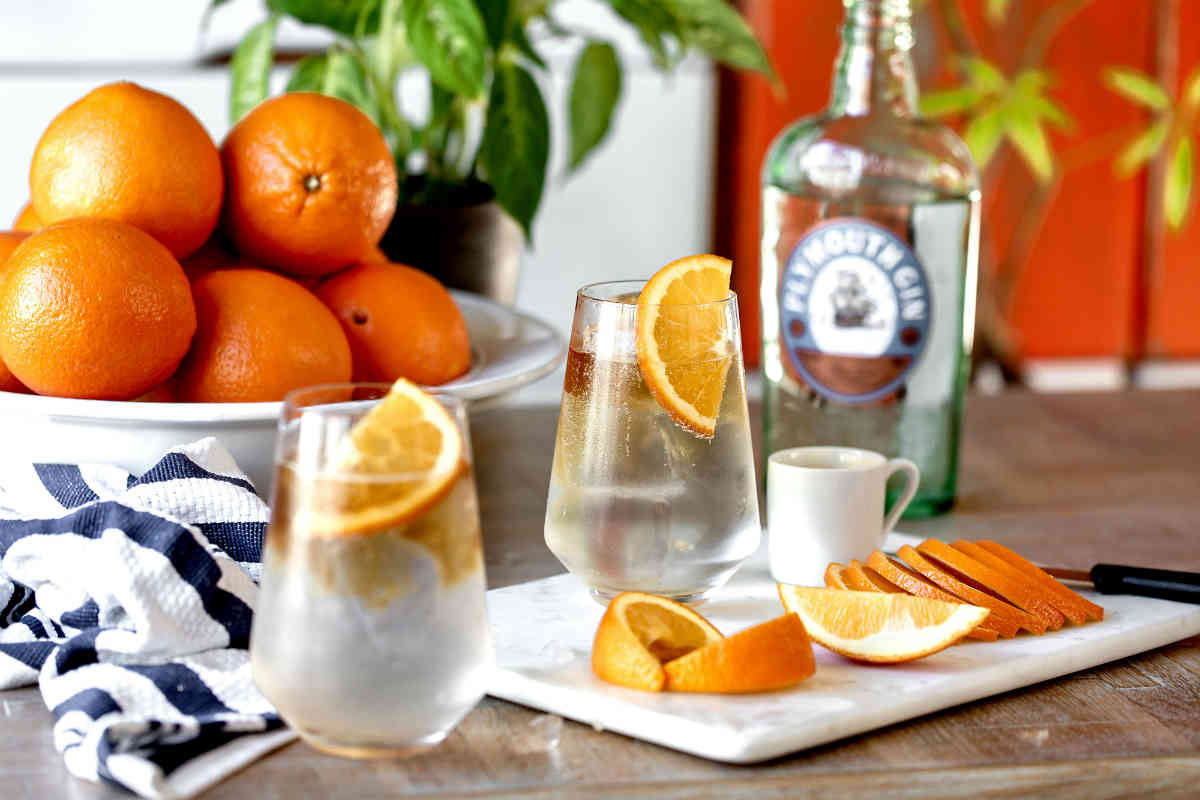In the more than two decades that Sean Harrison has served as Plymouth Gin’s Master Distiller, he’s overseen the iconic brand’s growth from a sleepy historical artifact to an international bartender’s favorite and witnessed three changes in ownership. And at some point, he even became comfortable with the job title he’s held since 1999.
“I feel like I’ve sort of grown into it over the last 25 years, but when I started using it, I was not the master of anything, to be brutally honest,” Harrison says.
This isn’t false modesty. Harrison grew up in the small town of Kendal in Northwest England and left it to join the Royal Navy. He departed the Royal Navy as a lieutenant and continued living in Plymouth, the site of his last deployment. Harrison soon met a girl, married, and found himself in desperate need of a job. While scanning wanted ads in the local paper, he stumbled upon an assistant manager’s job at the Plymouth Gin Distillery and sent his resume with little expectation of hearing back. Harrison got the job and started work in November 1994.
Stepping Inside Black Friar’s
Plymouth Gin had been in production for two centuries before Harrison’s first day of work. Since 1793 it had been distilled at Plymouth’s historic Black Friar’s building, which dates back to the 15th century and features a medieval hall with a timber roof. Plymouth Gin claimed the title of oldest working distillery in England, and was even protected by its own geographical indication (GI) status granted by the E.U.
However, things weren’t so rosy at Black Friar’s in 1994. While Plymouth Gin was still being produced, it was only made in small quantities as the distillery produced gins for other brands. And the Plymouth Gin that was being made was a shadow of its historical predecessor; it was distilled from cane and bottled at just 37.5% ABV. Harrison places the blame on Plymouth’s then-owner, Allied Distillers Limited.

Plymouth Gin
“Basically, the big company effectively ripped the heart out of what Plymouth Gin was. They cheapened the brand down and they used cheaper ingredients to make it. And it was just sitting around languishing.”
Harrison had started in an admin role, but the distillery’s tiny size—it then employed just four people—made exposure to the distilling side of the business inevitable. Before long, the head distiller and distillery manager were showing Harrison the ropes, and the neophyte moved into production.
“It was a bit of a job share, and a bit of learning something I had no idea existed at the time,” he says.
The Revival
Harrison had learned enough that by 1996, when the company was sold in a management buyout, he made a case to the CEO about how Plymouth Gin could be revived.
“I sat down with the CEO after the day that we were bought and I said, ‘Number one, you need to put the strength up to 40%,’ which he did, and ‘Number two, we need to go back to grain-based alcohol,’ which we did.”
But Harrison, who was now the distillery manager, saw more room for improvement. He discovered, with then-CEO and eventual Fever Tree Tonic founder Charles Rolls, that the perfect proof for Plymouth Gin was 41.2%. By 1998 Harrison had his perfect proof, new packaging, and even re-released the brand’s 114-proof Navy Strength Gin.
“Through a few things in the late ’90s, we managed to raise up Plymouth back to where it should have been,” says Harrison.
Creating a Category
Divining where Plymouth Gin should have been required a look back to the gin industry’s beginnings in the late 18th and early 19th centuries. In comparison to the other early gin producers, such as Gordon’s and Greenall’s, Plymouth was less juniper-forward and more balanced in its approach to botanicals.
“What Plymouth did when it came out is actually change the way gin was drunk,” Harrison says. “It made the ratios of all the ingredients a bit closer, and it brought forward the citrus notes.”
As Plymouth’s popularity rose through the 19th century, competitors began to copy the gin. Plymouth responded with lawsuits, which led to its recognition as a singular category by the courts. Eventually, it was granted GI status by the EU in 1989, which gave it the same protections afforded to other region-specific products like Parmigiano-Reggiano and Champagne.
To this day, “Did you know that Plymouth Gin is its own category?” remains a favorite quip of know-it-all gin nerds—even though Plymouth lost its GI status in 2015.
The End of a Category
In 2008 the EU decided to update and redefine the GI protections it had previously given spirits, based on changes that had occurred in the intervening decades. Every spirit under the GI umbrella, from Scotch to Cognac, was given seven years to re-apply for its GI status.
What Plymouth did when it came out is actually change the way gin was drunk.
Plymouth, which was by then owned by Pernod Ricard (who picked up the brand as part of its 2009 purchase of Sweden’s V&S Group, the owners of Plymouth since 2004) faced a dilemma. Because they were the only gin in the Plymouth category, they would be required to reveal trade secrets including their over-two-centuries-old recipe and would lose trademark rights to the name “Plymouth Gin.”
Ultimately, Plymouth did not re-apply and allowed its GI status to lapse in 2015. It was not an easy decision, but Harrison believes the right choice was made.
“Nowadays if you see a bottle of Plymouth Gin anywhere in the world the name is protected and it only comes from one distillery,” he says. “If we had gone down the GI route anybody could have made a Plymouth Gin… We could own the label design, the bottle design, the Mayflower design, all the things like that, except the two most important words, which were ‘Plymouth Gin.’”
The Bartender’s Gin
Plymouth has come a long way since Harrison’s days as a fresh-from-the-navy assistant manager, back when it produced just 5,000 cases of its flagship gin each year. The Navy Strength expression has been in constant production since its 1993 re-introduction to mark the brand’s 200th anniversary, and a Sloe Gin based on an 1893 recipe Harrison discovered in the company archives has joined the product line.
Some measure of that success is tied to industry trends at large—Harrison gives credit to the continuing “gin boom”—but Plymouth seems to hold a special place of reverence for many bartenders, earning a reputation as “the bartender’s gin.” For that aspect of its modern success, Harrison credits its past.

Plymouth Gin
“Because we earned our spurs over 100 years ago and the bartenders at the time realized how versatile Plymouth was, they started using it in many drinks,” he says. “And more people started writing cocktail books, and people started writing down just not “gin,” “whiskey,” or “bourbon,” they started writing down product names.”
By Harrison’s telling, perhaps no brand’s name was so consistently inked as Plymouth’s.
“Historically, most of the world’s classic cocktails, perhaps 80%, are gin-based. So, you end up with a lot of people writing books [with] a lot of gin cocktails, and then they put Plymouth Gin in those cocktails and name us.”
As a specific example, Harrison cites The Savoy Cocktail Book, written by Harry Craddock and published in 1930. Within the influential book, Craddock mentions Plymouth Gin 36 times. When the cocktail revival hit at the turn of the last century, the bartenders of a new millennium re-discovered Plymouth Gin within the classic recipe tomes.
“In the late ’90s, when this incarnation of the cocktail culture started again, all of these young guys at the time were busy reading old cocktail books,” says Harrison. “They kept coming across Plymouth Gin, and they kept putting us in cocktails. And then they trained the next generation the same way, and the next generation got trained, and you end up ingraining Plymouth Gin continuously into all of these young people learning. So, you almost have to use Plymouth Gin in a recipe to understand it before you can say, ‘Okay, I’m going to take another gin and balance this, or I want to do this with it, or actually I need a different gin to make it go in that direction.”
Harrison’s Martini
Harrison, of course, has some mixed drink opinions of his own. He’s most partial to mixing four parts of Plymouth Gin to one-part Lillet Blanc. Or if he’s going in a more strictly Martini direction, 10 parts of Plymouth Gin to one-part Dolin Dry Vermouth. He garnishes neither, and has strong opinions on the practice.
It’s become a tradition that with a Martini you twist the lemon and chuck it in without any consideration of what the other ingredients are.
“It’s become a tradition that with a Martini you twist the lemon and chuck it in without any consideration of what the other ingredients are,” he says. “Lillet and lemon do not go very well together. So, if you’re going to put a twist into that, it should be orange. And as you drink, the garnish imparts a bigger and bigger flavor into the drink, so it just dominates it. If the drink arrives with a garnish, I take it straight out because I don’t want the orange to change the balance of the drink. It’s amazing how many people follow a recipe without even giving it a thought. Why? Just, ‘a Martini needs a lemon garnish.’ No, it doesn’t. It needs a garnish that fits the recipe.”
“That’s What Plymouth Will Always Be”
Harrison may be stewarding a historic brand, but that doesn’t mean he isn’t creating new products. In fact, Harrison tends to find inspiration from the brand’s own archives.
One recent example is Mr. King’s 1842 Recipe, a 2019 limited release distributed only in the UK. The gin, based on an 1842 recipe discovered by Harrison, called for just two botanicals, juniper and orris root. But the master distiller added his own twist; he decided that those ingredients would be picked in a single day on a single mountain in Frontignano, Italy, to highlight the overlooked role of terroir in gin production.
“The growing conditions, the sun, the rain, the soil, and everything else effect essential oils,” Harrison says.
In the future, Harrison may try his hand at some similar experiments. But he has no plans to fundamentally change the centuries-old spirit he’s shepherded back to greatness.
“The reason why Plymouth has survived for 200 odd years is because, while there’s obviously been trends in the past, it’s managed to transcend those trends and not always be fashionable but just be there, in the bar, making really great drinks. And I think that’s what Plymouth will always be.”



